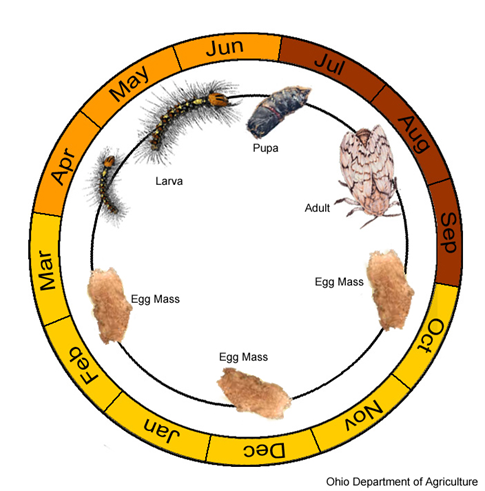“I’ll Be Back,” said the spongy moth
Spongy moth populations are down right now – but it is guaranteed that they will be back, so stay on the lookout.

In this case, the well-known saying “I’ll be back” (said with a strong Austrian accent) refers to the invasive and destructive spongy moth (formerly known as gypsy moth) or Lymantria dispar. High populations of spongy moth can defoliate trees, and the resulting stress may kill the tree. The resulting amounts of frass (caterpillar poop) from high numbers of large, hairy spongy moth caterpillars can make an unpleasant mess of your backyard or local park.
The population numbers of spongy moth were low this year, and there were no control methods applied in Macomb County. However, that does not mean they are gone for good. Spongy moth is well established in Michigan, and while Macomb County numbers are low now, they will increase and be high again in the not-so-distant future.
Therefore, homeowners and property managers need to remain vigilant for signs of spongy moth and report them to their local municipality or Michigan State University Extension office. City managers and township supervisors need to keep funds in their budgets to deal with spongy moth when it inevitably returns.
From October to April, be on guard for spongy moth egg masses on the trunks and branches of trees. Tan or buff egg masses can also be found on any hard surface such as plant pots, the wheel wells of cars, lawn furniture and yard equipment.
The caterpillar hatch is temperature-dependent and usually occurs in late April or early May. The caterpillars start out tiny and black, but by June are large and hairy with red and blue spots on their back, and voraciously feed on tree leaves. The caterpillars pupate and form brown cocoons in late June or July. Adult moths emerge from the cocoons usually in late July or early August. The moths live only a few days, with the flightless female form having white wings with black chevrons and the smaller male form being active fliers with brown wings with dark markings.

The female spongy moths lay their egg masses from August through September. The egg masses are usually buff or tan in color and about the size of a quarter but can be up to 3 inches long. The egg masses overwinter and hatch the following April or May.
Again, if you see any of these life stages of spongy moth, be sure to report it to your local municipality or MSU Extension office. Stay vigilant!
For additional information on spongy moth in Michigan, visit MSU Extension’s resource website.



 Print
Print Email
Email
